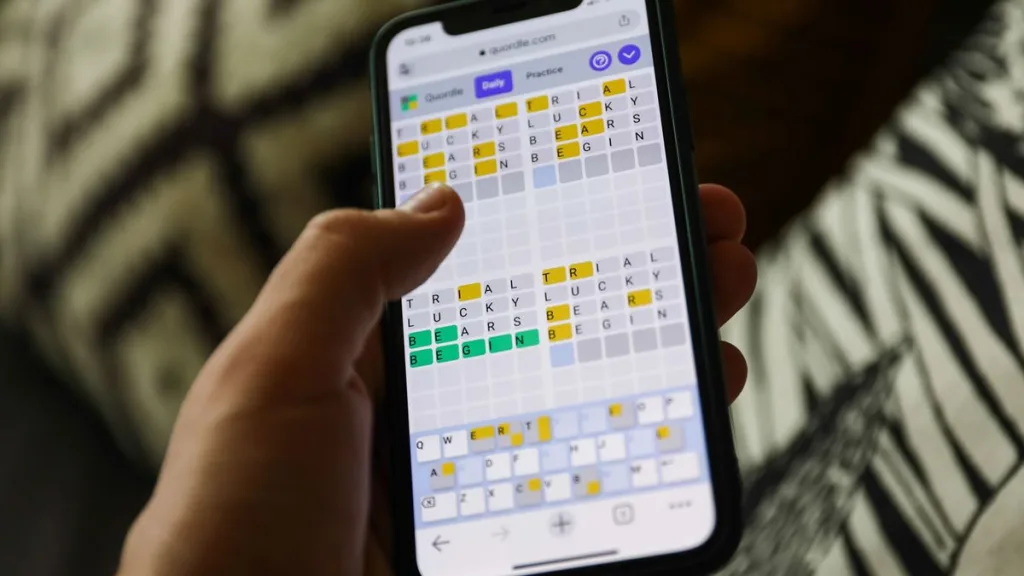As word puzzle enthusiasts across the globe open their browsers for their daily mental challenge, Quordle continues to test vocabulary skills and strategic thinking in ways its predecessor Wordle never could. The quadruple-word challenge requires players to simultaneously solve four five-letter words within just nine attempts, creating a delicate balance between information gathering and educated guessing. For many players, this Tuesday puzzle represents a morning ritual, a midday brain break, or an evening wind-down exercise that keeps cognitive skills sharp.

Whether you’re a Quordle veteran looking to maintain your streak or a newcomer struggling with the multi-word format, today’s April 8th puzzle offers an engaging mix of common and uncommon terms that will test your wordplay abilities. This guide provides carefully calibrated hints that help you solve the puzzle yourself, with complete answers available only when you’re ready to see them.
Table of Contents
Quordle April 8 Solutions: Strategic Hints and Complete Answers
Today’s Quordle presents an interesting mix of vocabulary that balances everyday language with more specific terms. If you’re struggling to crack the code on this Tuesday’s puzzle, our graduated hint system allows you to get just the right amount of help without spoiling the satisfaction of solving it yourself. The carefully designed hints progressively reveal more information, from vowel counts to starting letters, allowing you to determine how much assistance you need.
The first word in today’s puzzle (top-left) contains just one vowel and begins with “W” – a relatively uncommon starting letter that might require some strategic guesses. This word refers to a measurement or dimension, specifically describing the state of being wide. With no repeated letters, this word follows a straightforward consonant-vowel pattern that makes it accessible once you identify the starting letter.

In the top-right position, today’s second word begins with “V” and contains two vowels. This word describes a protective or shielding component, particularly associated with headgear, that allows visibility while providing coverage. Like the first word, it contains no repeated letters, making it somewhat easier to deduce through the process of elimination once you’ve identified a few correct letters.
| Word Position | Starting Letter | Vowel Count | Repeated Letters | Word Category |
|---|---|---|---|---|
| Top-Left | W | 1 | None | Measurement term |
| Top-Right | V | 2 | None | Protective equipment |
| Bottom-Left | M | 2 | None | Achievement/Recognition |
| Bottom-Right | B | 2 | Yes (one letter) | Nature/Action term |
The bottom-left word starts with “M” and contains two vowels without any repeated letters. This word refers to a metallic award or recognition, often associated with achievements in sports, military service, or other notable accomplishments. The word structure follows a familiar pattern that makes it relatively straightforward to identify if you’ve established a few correct positions.
Finally, the bottom-right word begins with “B” and features two vowels, with one letter appearing twice. This word can function both as a noun describing a small stream and as a verb meaning to tolerate or endure something. The repeated letter creates an additional challenge, as players must determine which letter appears in multiple positions.
For those seeking additional strategy tips, consider using words with common letters (E, A, R, T, S) in your initial guesses to establish a broad foundation. Words like “CRANE,” “ADIEU,” or “STARE” can help identify several correct letters across all four puzzles simultaneously. Remember that in Quordle, unlike Wordle, conservation of guesses is crucial – you need to make significant progress on all four words relatively quickly.
If you’ve exhausted your strategies and need the complete solutions, today’s Quordle answers for April 8, 2025, are:
- WIDTH (top-left)
- VISOR (top-right)
- MEDAL (bottom-left)
- BROOK (bottom-right)
Beyond the standard Quordle, today’s Chill mode (which offers 12 attempts instead of 9) features the words CABLE, CRAMP, VIPER, and MAYBE. The more challenging Extreme mode (with only 8 attempts) presents BUNCH, TAFFY, SPORT, and SWEAT. For those tackling the Sequence mode or Weekly Challenge, separate hint systems are available to guide you through those specific variations.
Marvel Rivals: How to Get The Unlimited Thing Skin Completely Free Through April 16
Frequently Asked Questions
What’s the best strategy for consistently solving Quordle puzzles?
The most effective strategy for Quordle combines efficient information gathering with tactical word selection. Start with two or three words that collectively use 15-20 different letters, focusing on common consonants (R, S, T, N, L) and vowels. Words like “STARE,” “DOILY,” and “CHUNK” used in sequence can help identify correct letters across all four puzzles simultaneously. Once you’ve established several correct letters, focus on solving the easiest puzzle first—typically the one where you’ve identified the most letters—to conserve guesses. Unlike Wordle, where you might aim for the solution immediately, in Quordle you should spend your first 3-4 guesses gathering information rather than attempting solutions.
When down to your final 2-3 guesses, prioritize words that could solve multiple puzzles at once when possible. Most importantly, track eliminated letters carefully, as Quordle’s four-puzzle format makes it easy to forget which letters have been ruled out for each specific word position, leading to wasted guesses on impossible combinations.
How does Quordle compare to other word games like Wordle and NYT Spelling Bee?
Quordle differentiates itself from other popular word games through its multi-puzzle approach and strategic depth. While Wordle focuses on solving a single five-letter word in six attempts—emphasizing deduction through color-coded feedback—Quordle’s four simultaneous puzzles with nine attempts creates a more complex challenge that requires balancing information gathering across multiple words. This makes Quordle significantly more difficult than Wordle but offers greater satisfaction upon completion. Compared to the NYT Spelling Bee, which emphasizes vocabulary breadth by asking players to create as many words as possible from seven letters, Quordle focuses on deductive reasoning and strategic guess allocation.
Spelling Bee rewards extensive vocabulary without attempt limitations, while Quordle tests efficiency and pattern recognition within strict constraints. The NYT Connections game shares Quordle’s multi-solution approach but focuses on categorization rather than word-building. Players typically find that Quordle requires more strategic thinking than Wordle but less specialized vocabulary than NYT Crosswords, placing it in a sweet spot of accessibility and challenge that explains its growing popularity among word game enthusiasts who found Wordle too simple after mastering its patterns.








